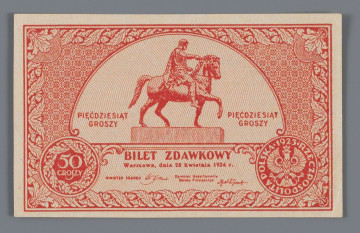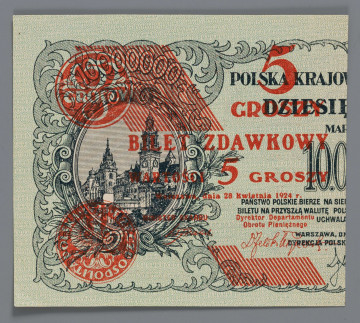
50 groshes [Polish: grosze]
1924
National Museum in Lublin
Part of the collection: Paper money during the Second Polish Republic
Its task was to ensure the performance of small transactions in the absence of a sufficient number of coins in circulation. The need to heal the economic situation in the country, including the currency reform, had been visible in Poland for a long time. The main problem that delayed this task was the inability to build an adequate political base in the divided Sejm. It was only at the end of 1923 that a government with the legitimacy to undertake the necessary corrective measures was formed. It was headed by Władysław Grabski. The need to take decisive and swift action resulted in temporary solutions. One of these was the introduction into circulation of a perfunctory ticket to replace the coins that could not be minted in sufficient quantity. The currency reform entered into force on 28 April 1924 and this date was printed on the pass tickets. However, as far as the ten-, twenty- and fifty-grosz tickets were concerned, their introduction into circulation took place somewhat later. In the case of the ten- and fifty-groszy tickets, this happened on 5 May, while the twenty-groszy tickets did not appear until 7 July 1924. All three denominations had a similar graphic design, which consisted of a central, framed field with a symbol clearly associated with the culture and history of Poland, and on the sides there were images of the obverse and reverse of the replaced coin. In the case of the twenty-grosz coin the central motif was the Warsaw Nicolaus Copernicus statue by Bertel Thorvaldsen. The colour scheme was kept in shades of dark brown. Twenty-penny tickets were issued in a total circulation of 19,872,000 copies, which amounted to just under 3,974,400 zloty.
These tickets were withdrawn from circulation based on a decision of the Minister of Treasury dated 21 October 1924. The period in which they were to be exchanged and accepted as payment was set for the time between 1 November 1924 and 31 January 1925. The regulation also informed that the exchange of tickets could take place at the headquarters of the Central State Treasury, Treasury Funds and branches of Bank Polski, and additionally at the Government Treasury in Gdańsk.
Leszek Poniewozik
Author / creator
Dimensions
cały obiekt: height: 78 mm, width: 47 mm
Object type
paper money
Technique
Material
paper
Creation time / dating
Creation / finding place
Owner
The National Museum in Lublin
Identification number
Location / status

1924
National Museum in Lublin

1924
National Museum in Lublin

1924
National Museum in Lublin
DISCOVER this TOPIC
Castle Museum in Łańcut
DISCOVER this PATH
Educational path